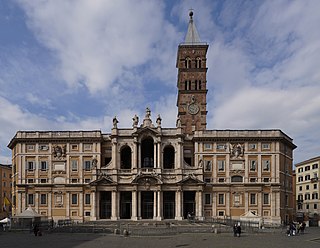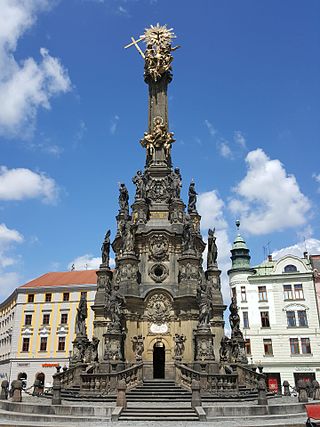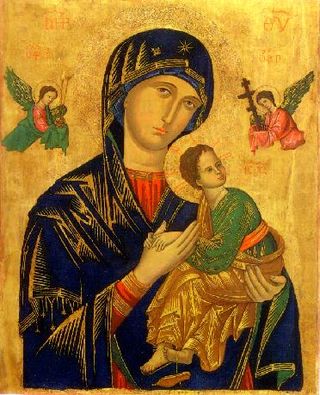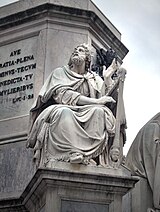
The Immaculate Conception is the belief that the Virgin Mary was free of original sin from the moment of her conception. It is one of the four Marian dogmas of the Catholic Church. Debated by medieval theologians, it was not defined as a dogma until 1854, by Pope Pius IX in the papal bull Ineffabilis Deus. While the Immaculate Conception asserts Mary's freedom from original sin, the Council of Trent, held between 1545 and 1563, had previously affirmed her freedom from personal sin.

Santa Maria della Concezione dei Cappuccini is a Roman Catholic church located at Via Vittorio Veneto, 27, just north of the Piazza Barberini, in Rome, Italy. It is the first Roman church dedicated to the Immaculate Conception.

The Basilica of Saint Mary Major, or church of Santa Maria Maggiore, is a Major papal basilica as well as one of the Seven Pilgrim Churches of Rome and the largest Catholic Marian church in Rome, Italy.

Piazza di Spagna, at the bottom of the Spanish Steps, is one of the most famous squares in Rome, Italy. It owes its name to the Palazzo di Spagna, the seat of the Embassy of Spain to the Holy See. There is also the famed Column of the Immaculate Conception of the Blessed Virgin Mary.

The Feast of the Immaculate Conception celebrates the Immaculate Conception of the Blessed Virgin Mary on 8 December, nine months before the feast of the Nativity of Mary on 8 September. It is one of the most important Marian feasts in the liturgical calendar of the Roman Catholic Church.

Marian columns are religious monuments depicting Virgin Mary on the top, often built in thanksgiving for the ending of a plague or for some other reason. The purpose of the Holy Trinity columns was usually simply to celebrate the church and the faith, though the plague motif could sometimes play its role in their erection as well. Erecting religious monuments in the form of a column surmounted by a figure or a Christian symbol was a gesture of public faith that flourished in the Catholic countries of Europe especially in the 17th and 18th centuries. Thus they became one of the most visible features of Baroque architecture. This usage also influenced some Eastern Orthodox Baroque architecture.

Gesù Nuovo is the name of a church and a square in Naples, Italy. They are located just outside the western boundary of the historic center of the city. To the southeast of the spire, one can see a block away the Fountain of Monteoliveto and the piazza of the church of Sant'Anna dei Lombardi. The square is a result of the expansion of the city to the west beginning in the early 16th century under the rule of Spanish viceroy Pedro Alvarez de Toledo. The square of Gesù Nuovo contains three prominent landmarks:

Mary, the mother of Jesus in Christianity, is known by many different titles, epithets, invocations, and several names associated with places.

Fulgens corona is an encyclical by Pope Pius XII, given at St. Peter's, Rome, on 8 September 1953, the Feast of the Nativity of the Blessed Virgin Mary, in the fifteenth year of his Pontificate. The encyclical proclaims a Marian year for 1954, to commemorate the centenary of the definition of the dogma of the Immaculate Conception of the Virgin Mary.

The Mariology of the popes is the theological study of the influence that the popes have had on the development, formulation and transformation of the Roman Catholic Church's doctrines and devotions relating to the Blessed Virgin Mary.

Catholic Marian churches are religious buildings dedicated to the veneration of the Blessed Virgin Mary. These churches were built throughout the history of the Catholic Church, and today they can be found on every continent including Antarctica. The history of Marian church architecture tells the unfolding story of the development of Catholic Mariology.

Mary has been one of the major subjects of Western Art for centuries. There is an enormous quantity of Marian art in the Catholic Church, covering both devotional subjects such as the Virgin and Child and a range of narrative subjects from the Life of the Virgin, often arranged in cycles. Most medieval painters, and from the Reformation to about 1800 most from Catholic countries, have produced works, including old masters such as Michelangelo and Botticelli.

The Ancient Royal and Eminent Basilica Collegiate of Our Lady of the Alms, better known as Basilica della Colleggiata, is a church in Catania, Sicily, southern Italy. Finished in 1794, it is an example of Sicilian Baroque.
The Pontifical Academy of the Immaculate Conception or Pontifical Academy of (Mary) Immaculate, Italian: Pontificia Accademia dell'Immacolata, was an academic honorary society established in Rome by the Catholic Church for the advancement of the Marian dogma of Immaculate Conception.

Grotta di Lourdes is an artificial cave in the Vatican gardens. It was built in 1902–05 and is a replica of the Lourdes Grotto in France. The context of building this grotto is the vision of the Madonna that a young girl, Bernadette Soubirous, experienced 18 times. Prior to that the Pope had promulgated the dogma of the Immaculate Conception in 1854.

Santa Maria della Concezione is a church in Rome, located on Piazza Campo Marzio in the Campo Marzio rione. It serves as the national church in Rome for Syriac Catholics.

San Francesco d'Assisi is a 16th-century-style church dedicated to Saint Francis of Assisi, located in Alcamo, province of Trapani, Sicily, southern Italy.

The Co-Cathedral of Saint Mary of the Assumption and Saint Catellus is the Roman Catholic duomo or cathedral of Castellammare di Stabia in the metropolitan city of Naples, in the region of Campania, Italy. It is the main church in Castellammare di Stabia and it is co-cathedral of the Archdiocese of Sorrento-Castellammare. It was built in 1587 and was consecrated in 1893. Inside on display for worship is the statue of Saint Catello, the patron saint of the city.

Ursula Benincasa,, born around 1550 and died in Naples on 20 October 1618, was an Italian nun and mystic, declared venerable, founder of the Oblate Sisters and Hermitage of the Contemplative Sisters of the Immaculate Conception, later the Theatine Sisters of the Immaculate Conception of the Virgin Mary.

The Colonna dell'Immacolata Concezione is a monumental sculpture, whose centerpiece is a bronze statue of the Virgin of the Immaculate Conception atop a column, erected in 1631 on Piazza San Domenico in Palermo, Sicily. The monument, which stands in front of the church of San Domenico is also referred to as the Colonna di San Domenico or Monumento all'Immacolata. The 18th-century monument falls within the tradition for example, of the guglia or spire monuments common to Naples.
























